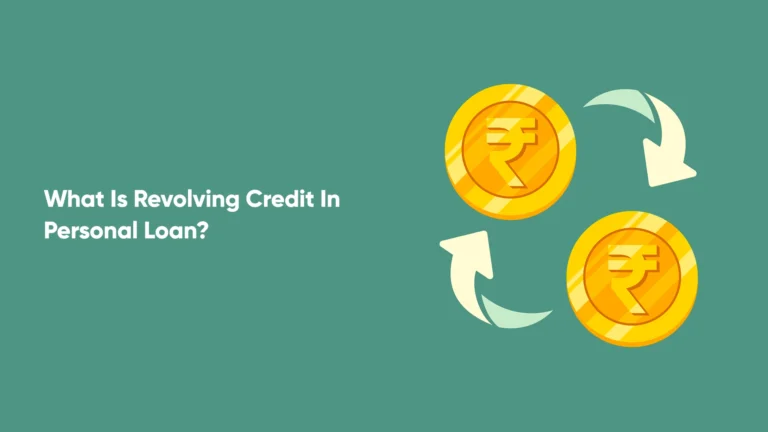Revolving credit is a type of borrowing where you are given a credit limit that you can use, repay, and reuse as needed. Unlike a one-time loan, this credit “revolves,” meaning you can borrow multiple times without reapplying. A common example is a credit card or an overdraft facility on a bank account.
For instance, imagine Rajesh has a revolving credit limit of ₹1,00,000. He uses ₹40,000 to pay for his sister’s wedding arrangements and repays ₹20,000 after two months. Now, his available balance is ₹80,000 (₹1,00,000 limit – ₹20,000 still outstanding). Rajesh can borrow again from this pool whenever required, making it a flexible option for managing recurring family and personal expenses.
Table of Contents
ToggleHow Revolving Credit Differs from Other Loan Types
Revolving credit works very differently from fixed-term loans like personal loans or car loans. In a personal loan, you get one lump sum and repay it in fixed EMIs over a set period. But with revolving credit, on the other hand, allows repeated use of funds up to your approved limit, almost like a refillable wallet.
Key Differences (Revolving Credit vs Installment Loan):
- Usage: Revolving credit is a reusable pool of funds, while instalment loans are a one-time disbursal.
- Repayment: Revolving credit lets you pay flexibly (minimum due or full balance), whereas instalment loans require fixed EMIs.
- Limit Reset: With revolving credit, your limit is restored as you repay; in instalment loans, the loan closes once repaid.
- Purpose: Revolving credit suits ongoing or unexpected needs (like medical bills, travel, or shopping), while installment loans fit one-time big expenses (like buying a car or funding a wedding).
Revolving Loan Example Explained
Let’s say Neha has a revolving credit limit of ₹50,000 from her bank. She uses ₹20,000 for travel bookings. At the end of the month, she has two options:
- Pay the full ₹20,000 and restore her credit limit back to ₹50,000.
- Pay the minimum ₹2,000 (10%), but the remaining ₹18,000 will carry forward with interest.
Next month, Neha needs ₹15,000 for a medical emergency. If she has repaid ₹10,000, her available limit becomes ₹40,000 (₹50,000 – ₹10,000 still outstanding). She can borrow this ₹15,000 without reapplying. This cycle continues, making revolving loans a flexible financial tool but one that requires disciplined repayment.
Also Read: 6 Difference Types of Personal Loan
Key Features and Benefits of Revolving Credit
Revolving credit comes with several advantages that make it a smart financial tool for both individuals and businesses. It gives you the flexibility to borrow and repay funds as needed:
- Access Funds Anytime: With revolving credit, you can borrow up to your approved limit, repay, and then borrow again. This gives you continuous access to funds without applying for a new loan each time.
- Emergency Support: Acts as a safety net for unexpected needs such as medical bills, urgent repairs, or travel emergencies, helping you manage stress with quick access to money.
- Interest Only on What You Use: Unlike fixed-term loans, interest is charged only on the amount you actually spend, not the entire credit limit. This can reduce your overall borrowing cost.
- Flexible Repayments: You can choose to pay the full balance or just the minimum due, giving you freedom to manage cash flow as per your situation.
- Build a Strong Credit History: Timely repayments and low credit utilisation improve your CIBIL score, making it easier to qualify for future loans at better rates.
- Better Cash Flow for Businesses: Companies can use revolving credit to cover short-term expenses, ensuring smooth operations even when revenues dip.
- Rewards & Perks: Credit cards, a common form of revolving credit, often come with cashback, discounts, or reward points that add extra value to your spending.
- Seize Opportunities Quickly: Whether it’s a festive sale, business expansion, or a travel deal, revolving credit lets you grab opportunities without waiting for a fresh loan approval.
Understanding Charges on Revolving Credit
Revolving credit may feel convenient, but it’s important to understand the different charges that come with it. Beyond the interest you pay on borrowed funds, there can be setup costs, annual fees, and penalties for late or missed payments. Knowing these charges helps you manage costs and avoid surprises.
- Interest Charges: The main cost of revolving credit. Interest is applied only to the amount you’ve borrowed (not the full credit limit) and is often calculated daily. Rates can be variable, meaning they may increase or decrease.
- Annual or Renewal Fees: Some facilities, like credit cards, charge an annual fee to keep your line of credit active.
- Commitment Fees: A charge on the unused portion of your credit limit, essentially for keeping funds available even if you don’t use them.
- Processing or Arrangement Fees: One-time fees lenders may apply when setting up the revolving credit facility.
- Late Fees and Penalties: Missing a payment or paying less than the minimum due can attract hefty fines and negatively impact your credit score.
- Over-limit Charges: If you exceed your approved limit, additional penalties may apply.
To avoid surprises, always read your loan agreement carefully, check the APR for the real cost of borrowing, and stay alert to extra charges like processing or annual fees. Be clear about your payment deadlines and minimum dues, and regularly track your account activity. These simple habits will help you manage revolving credit wisely and keep your finances under control.
Risks and Drawbacks of Revolving Credit
The main risks of revolving credit include high interest rates that can make debt costly if balances are not cleared on time, the temptation to overspend due to easy access to funds, and the danger of falling into a debt cycle. Mismanaging it, such as making late payments or using too much of your limit, can lower your credit score, while extra fees like annual charges or penalties further add to the cost.
1. High Interest Costs
If you don’t clear your balance in full, the remaining amount attracts interest, which can be quite high. Over time, this makes your debt much more expensive, especially if you keep paying only the minimum due.
2. Overspending and Debt Buildup
Since funds are always available, it’s easy to overspend and borrow more than you can manage. This often traps borrowers in a debt cycle that becomes hard to escape.
3. Credit Score Damage
Using too much of your credit limit or missing payments can bring down your credit score. A lower score reduces your chances of getting loans or credit cards in the future.
4. Extra Fees
Annual fees, processing charges, or penalties for late payments can quietly add up and make borrowing costlier.
5. Overextension of Finances
The convenience of revolving credit may encourage you to borrow more than your income can handle, especially if your expenses rise or your earnings change.
How to Manage Revolving Credit Responsibly
Revolving credit can be a great financial tool if used wisely. The key is to stay disciplined so that flexibility doesn’t turn into debt stress. Here’s how you can manage it smartly:
- Avoid Late Fees: Always clear your dues by the due date to save money on penalties. A consistent payment record shows lenders that you are a reliable borrower.
- Stay Under 30%: Try not to use more than one-third of your total credit limit. This keeps your credit score healthy.
- Pay in Full When Possible: Clearing your balance each month helps you avoid high interest charges.
- Check Statements Regularly: Look for errors or suspicious charges to avoid losses.
- Track Your Spending: Use mobile apps or SMS alerts to stay aware of how much you’re borrowing.
- Borrow Only When Needed: Ask yourself if the purchase is essential before using credit.
- Reserve for Emergencies: Use revolving credit as a safety net for medical expenses, travel emergencies, or urgent repairs.
- Limit Multiple Accounts: Managing too many credit lines increases complexity and risk of missing payments.
- Know the Terms: Understand your credit limit, interest rate, and fees so you’re never caught off guard.
Frequently Asked Questions
What Is The Difference Between Revolving Credit And A Personal Loan?
A personal loan from Zype gives you a lump sum with fixed EMIs, while revolving credit lets you borrow, repay, and reuse funds up to a set limit.
How Are Interest Charges Calculated On Revolving Credit?
Interest is charged only on the outstanding balance you’ve used, usually calculated daily until repayment.
Can Revolving Credit Improve My Credit Score?
Yes, if you repay on time and keep utilisation low, revolving credit helps build a strong credit history and improves your CIBIL score.
What Are The Typical Fees Associated With Revolving Credit In India?
Common fees include annual or renewal charges, late payment penalties, processing fees, and sometimes commitment fees on unused limits.
Is Revolving Credit Suitable For Emergency Expenses?
Yes, revolving credit acts like a ready fund, making it useful for medical bills or urgent repairs.
How Much Revolving Credit Should I Use Without Hurting My Credit Score?
Keep your usage below 30% of your total limit. This shows responsible credit behaviour and protects your score.









